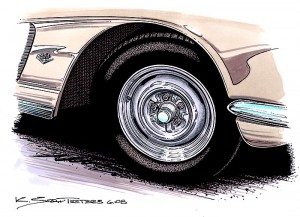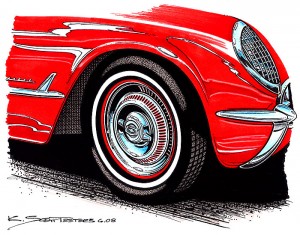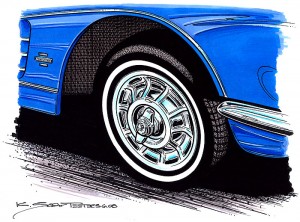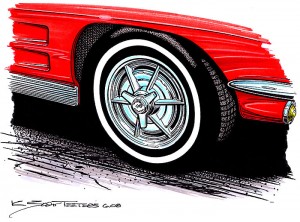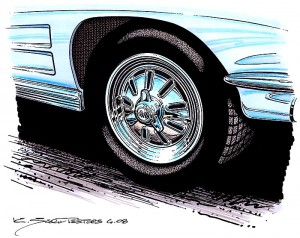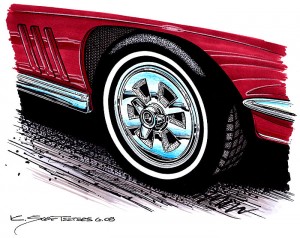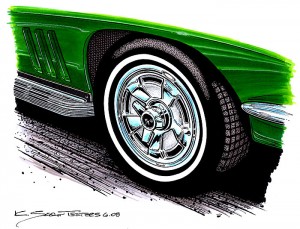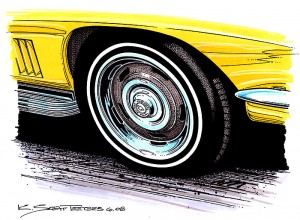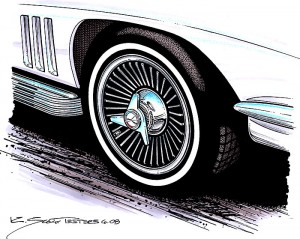A Historical Look Back at the Wheels Vettes Ride On
After the characteristics of body shape and color, wheels are arguably the most definitive aspect of a car’s personality. A great looking set of wheels can make an average car (such as a Chevy Nova) look like a hot car with just a set of Cragar wheels. Having good looking wheels is the fastest way to get people to tell you, “Hey man, nice wheels”
Looking back at Corvette wheel designs, it’s amazing to realize that the first three generation base Corvettes road on stamped steel wheels. It wasn’t until Corvette’s 11th season that buyers had any wheel option at all. The ‘63 to ‘67 knock-off and knock-off-styled wheels were quite the ticket. Then from ‘68 to ‘72, it was back to stamped steel wheels only. They were beautifully styled wheels but due to their growing width and larger tires, were adding a lot of unsprung weight. Corvette buyers finally got a wheel option again in ‘73 with the very nice looking aluminum alloy wheels that definitely enhanced the Mako Shark looks of the C3 cars.
Corvette buyers saw the last of the stamped steel wheels at the close of the ‘82 model year. With the introduction of the C4 in ‘84, its been alloy wheels all the way, providing Corvette buyers with some of the most beautiful automotive wheel designs made. Of course, we all have our preferences, but when you look back at the history of Corvette wheel design, they are truly second to nun.
Your Basic Stamped Steel Wheel
It doesn’t get any more basic than this. Yes, the same 15” x 6” steel wheels that were mounted an a regular Chevy. Enthusiasts even raced their Corvettes on plain steel wheels. Just pop off the hub caps and go racing. When you look at pictures of old Corvette racers, almost no one had special wheels.
1953 – 1955 Hub Cap
It’s helpful to refresh one’s perspective on cars of the early ‘50s to appreciate the stunning good looks of the ‘53 to ‘55 Corvette. A Chevy Sedan towers over the Corvette. The emphasis was on the overall body shape and the hub caps blend very nicely. The hub cap was a single stamped disc with two chrome spinner ornaments. The ribs along the inner dish reflected nicely around the outer ring.
1956 – 1962 Hub Caps
The first major styling revision arrived in ‘56. The all new body and interior road on the same basic X-frame chassis. While the previous design was pretty, the new styling was hot. Like the previous hub cap, this was a stamped disc with a chrome spinner. The design featured 10 bold rib that connect to the center ring. Tough-looking wheels for the Corvette’s new tough-guy looks.
1963 Hub Caps
The ‘63 Sting Ray was a real jaw-dropper. Again, look at other cars from ‘63 and you’ll realize that you are looking at a true classic. Aside from the engine and transmission, the rest of the Sting Ray was completely new. Unlike the C1, C3, and the rest of the Corvette generations, there was a different hub cap for every year. Still riding on the same 15” x 6” steel wheel, the new hub cap features six thin ribs that connect the inner dish with the outer ring. The spinner ornament would be on every Corvette hub cap through ‘66.
1964 Hub Caps
Lucky for C2 Corvette spotters that each year C2 Corvette had dedicated wheels. Every year of the short C2 production run was punctuated with subtle detail changes not limited to just hub caps. Designers obviously were having fun tweaking grills, fender vents, hoods, back up lights, and interior details. The 15-inch hub caps featured nine narrow slots pointing to the center spinner. The center section of the caps was angled outward.
1965 Hub Cap
All previous Corvette hub caps were either dished in or out. The ‘65 hub cap was slightly raised and flat, with six pie-like slots. The flat surface and outer ring were chrome and the slots had a mat finish.
1966 Hub Cap
Corvettes finally got a mag-style hub cap in ‘66. Five-spoke mag wheels were all the rage in the mid-’60s. The center section was connected to the outer ring with 5 mag spokes that angled inward. The ring and top surface of the mag spokes were chrome finished with a mat finish center dish. Since Corvette hub caps could be ordered from any Chevy parts department, a lot of Impalas, Chevelles, and Novas wore ‘66 Corvette hub caps. Remember, Corvettes were still riding on 15” x 6” stamped steel wheels, so hub caps were completely interchangeable. However, it was very rare to see C1 and C2 Corvettes with odd year hub caps.
1967 Rally Wheels
Considered by many to be one of the nicest-looking Corvette wheels designs, the Rally Wheels arrived in ‘67 and continued on as the base Corvettes standard wheel through to ‘82. The new design took the standard 15” x 6” stamped steel wheel and added five slots that theoretically helped brake venting, but mostly just looked cool.
The design was similar to the new after market slotted aluminum wheels that were becoming very popular. The beauty ring reflected the slots in the steel wheel and the center cap finished off the design. The classic center spinner was gone due to safety regulations. These wheels were very popular and it’s not uncommon to see earlier Corvettes wearing ‘67 Rally Wheels.
1963 – 1967 Knock-Off Wheels
The trick setup for C2 Sting Rays was the optional cast-aluminum knock-off wheels. Priced at $322, the knock-offs weren’t the most expensive option, but close to it. Although we take aluminum wheels for granted these days, Chevrolet had a difficult time with the early ‘63 knock-offs. Due to the porosity of the aluminum, the early design had trouble keeping air in the new tubeless tires.
No ‘63 Corvettes were recorded having the knock-off wheels, but many were retro-fitted when the final wheels were available. The knock-off design was racing inspired, with the wheel held on with one large nut with a spinner that you had to hit with a mallet to get the wheels off. The ‘63 design had either two or three wing spinners. The design and size of the ribbed aluminum wheel stayed the same from ‘63 to ‘66 with variations of paint applications between the wheel’s ribs and finish on the center knock-off cap. The design radically changed in ‘67 into a “knock-off-style” wheel.
Due to safety concerns similar to the spinner issue, the center section of the spinner hub was actually a cap that covered a standard 5-bolt pattern. They looked like knock-offs, but weren’t. But the good news was that the simpler design cost less at $262, five years into the Sting Ray’s production run.
Scott
PS – This article was originally published in the December 2008 issue of VETTE Magazine.
You can catch Pt. 2 of this 3-part feature article HERE.
And Pt. 3 HERE.
Also, in September I will be updating the series for VETTE Magazine. The original set of illustrations were completed in August 2008 and ended with the ZR1 wheels. The update will cover all of the new wheels since then. The update will most likely run in VETTE sometime in early 2012.
[nggallery id=15]


